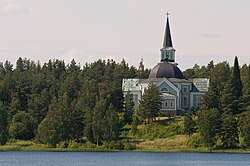Ruokolahti
Ruokolahti
Ruokolax | |
|---|---|
Municipality | |
| Ruokolahden kunta Ruokolax kommun | |
 Church in Ruokolahti | |
 Location of Ruokolahti in Finland | |
| Coordinates: 61°17.5′N 028°49′E / 61.2917°N 28.817°E | |
| Country | |
| Region | South Karelia |
| Sub-region | Imatra sub-region |
| Charter | 1868 |
| Government | |
| • Municipal manager | Jukka-Pekka Bergman |
| Area (2018-01-01)[1] | |
• Total | 1,219.85 km2 (470.99 sq mi) |
| • Land | 942.09 km2 (363.74 sq mi) |
| • Water | 276.4 km2 (106.7 sq mi) |
| • Rank | 81st largest in Finland |
| Population (2024-08-31)[2] | |
• Total | 4,731 |
| • Rank | 171st largest in Finland |
| • Density | 5.02/km2 (13.0/sq mi) |
| Population by native language | |
| • Finnish | 96.1% (official) |
| • Swedish | 0.2% |
| • Others | 3.6% |
| Population by age | |
| • 0 to 14 | 12.2% |
| • 15 to 64 | 52.7% |
| • 65 or older | 35.1% |
| Time zone | UTC+02:00 (EET) |
| • Summer (DST) | UTC+03:00 (EEST) |
| Climate | Dfc |
| Website | www |
Ruokolahti (Finnish: [ˈruo̯koˌlɑhti]; Swedish: Ruokolax;[6] literally translated the "Reed Bay") is a municipality of Finland, situated in south-eastern Finland, in the region of South Karelia. Neighbouring municipalities are Imatra, Lappeenranta, Taipalsaari, Puumala, Sulkava, Punkaharju, Parikkala and Rautjärvi. Ruokolahti covers an area of 1,219.85 square kilometres (470.99 sq mi) of which 23% is water.[1]
The municipality has 4,731 inhabitants (31 August 2024),[2] but the population doubles in summer as holidaymakers occupy the 3,000 summer cottages in the region.[7]
Ruokolahti is known for its natural environment, for example Kummakivi is a balancing rock located at 61° 29' 36.4596" N, 28° 25' 45.5016" E in Ruokolahti[8] and is protected.[9] In the west there is the Lake Saimaa and in the east there are hundreds of smaller lakes. The Salpausselkä ridges run through the area.[7]
The famous sniper Simo Häyhä lived in Ruokolahti for 57 years after the 1939–40 Winter War.[10] He is buried there in the graveyard of Ruokolahti Church.
The municipal coat of arms of Ruokolahti is a canting arms that directly refers to the name of the municipality, including reeds appearing in it. Wave line is usually used to describe a local body of water. The coat of arms was designed by Gustaf von Numers and was confirmed for use on September 11, 1951.[11]
Gallery
[edit]References
[edit]- ^ a b "Area of Finnish Municipalities 1.1.2018" (PDF). National Land Survey of Finland. Retrieved 30 January 2018.
- ^ a b "Finland's preliminary population figure was 5,625,011 at the end of August 2024". Population structure. Statistics Finland. 2024-09-24. ISSN 1797-5395. Retrieved 2024-09-25.
- ^ "Population growth biggest in nearly 70 years". Population structure. Statistics Finland. 2024-04-26. ISSN 1797-5395. Retrieved 2024-04-29.
- ^ "Population according to age (1-year) and sex by area and the regional division of each statistical reference year, 2003–2020". StatFin. Statistics Finland. Retrieved 2 May 2021.
- ^ a b "Luettelo kuntien ja seurakuntien tuloveroprosenteista vuonna 2023". Tax Administration of Finland. 14 November 2022. Retrieved 7 May 2023.
- ^ Namn på kommuner från finska till svenska; Kotimaisten kielten keskus
- ^ a b Hupponen, Paula (14 December 2003). "General Information". Discover Ruokolahti. Ruokolahti: Municipality of Ruokolahti. Archived from the original on 11 February 2010. Retrieved 15 February 2009. (Text from Discover Ruokolahti web site with a permission.)
- ^ "Karrta Paikka" (in Finnish). National Land Survey of Finland. Retrieved 1 December 2013.
- ^ Lehteinen, Markus. "Ruokolahden Kummakivi" (in Finnish). Retkipaikka. Retrieved 1 December 2013.
- ^ "Tappouhkaukset ja pelko varjostivat sotalegenda Simo Häyhän elämää". Yle Uutiset (in Finnish). 2017-06-18. Retrieved 2020-05-09.
- ^ Suomen kunnallisvaakunat (in Finnish). Suomen Kunnallisliitto. 1982. ISBN 951-773-085-3.
External links
[edit]![]() Media related to Ruokolahti at Wikimedia Commons
Media related to Ruokolahti at Wikimedia Commons
- Municipality of Ruokolahti – Official website
- Discover Ruokolahti – Information for tourists








